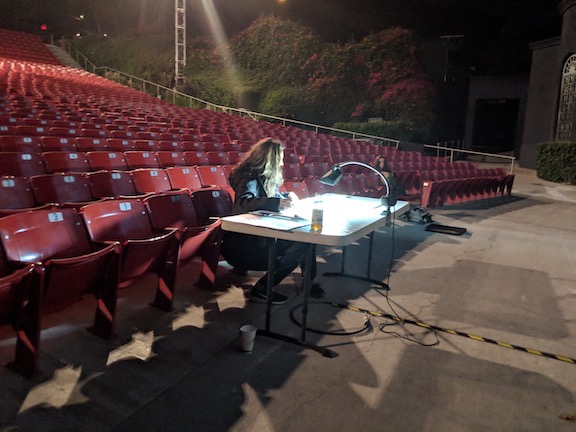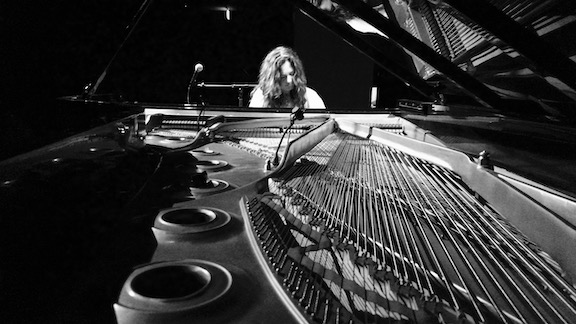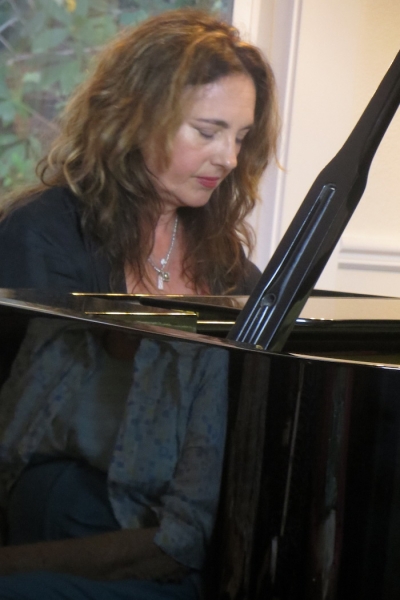Starr Parodi is one of a group of nine women film composers whose music will be featured in a Lincoln Center multi-media presentation on 9/20/19 called “Women Warriors: Voices of Change.” I have reviewed Starr’s two piano CDs and she played in one of my house concerts a few years ago, so this seemed like a perfect time to do an interview. I might add that I think this is one of the most interesting and inspiring interviews I’ve ever done. Enjoy!!!
KP: Hi Starr! We’ve met several times and you played in my house concert series in 2016 with Lisa Downing, but we’ve never done an interview. I’m not sure why we haven’t, but let’s fix that!
SP: Hi Kathy!!! Thank you so much for inviting me to do an interview. I loved playing at your house concert and hanging out with you! I’m so happy to do this!
KP: Great! As usual, you seem to be involved in a number of very different projects - all of them involving music, of course. Let’s talk about the “Women Warriors: Voices of Change” concert at the Lincoln Center in New York later this week (9/20/19).
SP: “Women Warriors: The Voices of Change” is the brainchild of Maestra Amy Andersson who is a conductor of the Orchestra Moderne NYC. She met a woman many years ago who was jailed for trying to register to vote and Amy made a promise to her to create a concert telling her story and also the stories of women leaders and visionaries including RBG, Malala, Rosa Parks & Emma Gonzalez. The music in the concert is written by leading Hollywood female film composers, paying homage to women who have inspired them, and accompanies documentary footage that will be shown as the 60-piece orchestra plays and highlights the different women’s stories.

Lisa Downing and Starr Parodi at Kathy's house in Florence, OR August 2016.
KP: I so wish I could be there! Which of your pieces will be featured?
SP: I worked on two of the pieces in the concert. “Joy of the Waters’’ is a celebratory orchestral piece in 6/4 that features flowing piano melody lines with the harmonic structure changing over pedal tones in the piano. The orchestra is playing soaring simple counter melodies over this as well as sometimes the woodwinds joining in to add colors to the piano lines.
The other piece that will be featured is a song written by my daughter, Isolde Fair, called “Rise.” She will be singing and will be accompanied by the orchestra as well as four snare drummers and a choral group. This song looks at life through a current teenager’s perspective and encourages perseverance.
KP: That’s really impressive! Isolde is making quite a name for herself already! We’ll talk about some of her other work later in the interview.
Crossover Media is doing a twelve-part series of podcasts related to the “Women Warriors” concert. Tell us about that.
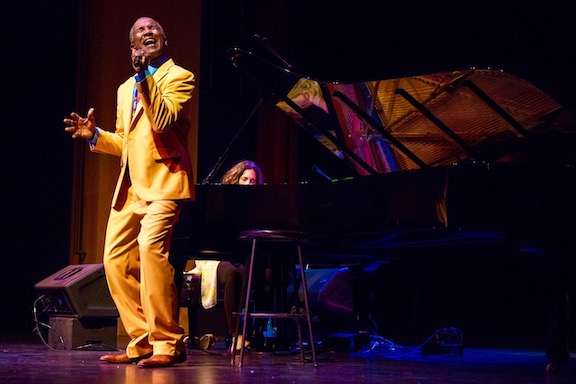
Starr and Louis Price performing "When Doves Cry."
SP: Crossover Media has created podcasts with interviews of all the composers and is helping to share their insights into the pieces they are composing and representing. Every one is different and it’s really interesting and wonderful to hear all the composers talk about their works. It’s an added perspective as the listener rarely gets to hear composers speak about their work in this way.
KP: You also recently released a new version of Prince’s iconic “When Doves Cry” with Louis Price, a former lead singer for The Temptations. How did that come about?
SP: I am a big Prince fan and had the opportunity to know him during the time I worked playing in the band on the Arsenio Hall Show in the early 1990’s. Louis Price is a dear friend and we have had many musical collaborations together. I recorded a piano album,
The Heart of Frida, a couple of years ago and created a solo piano arrangement of “When Doves Cry,” inspired by Frida Kahlo and her artist husband Diego Rivera, who were often referred to as the Elephant and Dove. Even though the arrangement was for solo piano, I always heard Louis’s expressive and soulful voice in my head singing the lyrics when I was playing the song. When I performed the piece live for the first time, I asked Louis if he would like to sing it with me, and the result was absolutely magical. The audience responded in such an enthusiastic way and we both knew we had to record it together.
Here’s the link on Spotify.
KP: I absolutely love The Heart of Frida and your solo piano arrangement of the song! I really like this new version, too!
You are currently the president of The Alliance for Women Film Composers. What does that involve?
SP: The Alliance is a community of about 400+ composers and colleagues (both women and men) and has been in existence for about 5 years. There is SO much to say about this wonderful group. We support and celebrate the work of female composers through professional development, networking opportunities, education and gaining visibility, and are working on bringing more diverse voices to TV/Film/and all visual media. I am so energized and thrilled about taking on this position and having the opportunity to work with the incredibly talented and visionary people in leadership and on the board. I feel like I will be able to make a real difference which is a great feeling!
KP: A few years ago, I reviewed Penka Kouneva’s The Woman Astronaut and was stunned to learn that the concept for the album was inspired in part by the fact that there are more women astronauts than women composers working on studio films. Have you had to overcome a lot of obstacles (and prejudices) along the way?
SP: How cool that you reviewed Penka’s album. She is a stunningly talented composer and such a wonderful person. Although the climate is starting to change, women composers are miserably underrepresented. I have been very fortunate to work with many incredibly creative, talented and lovely people in my career (both men and women) as an artist, musician and as a composer. That being said, the number of times I’ve been harassed, underpaid, or disrespected as a woman in this industry are too numerous to list. My goal is not to dwell on those situations but to always move forward and do my best work, while at the same time trying to make a positive change in people’s attitudes.
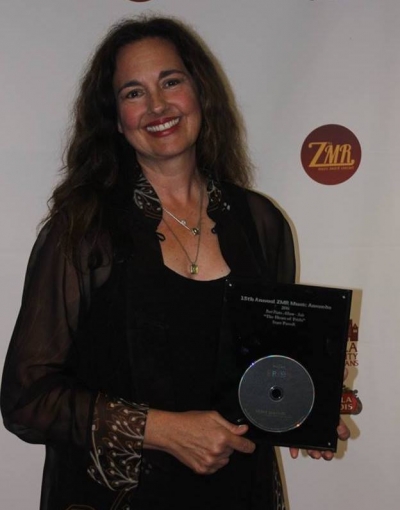
Winning the 2016 Zone Music Reporter Best Piano Album - Solo
award for "The Heart of Frida."
KP: I think there has been a lot of prejudice against women in many of the arts. I know when I was in art school (a million years ago!), several of the male teachers said that there had never been a famous woman artist (NOT true) and that women just don’t have what it takes. It’s not easy to wade through that kind of “stuff” (I’m being polite!) and rise above it. I have so much respect and appreciation for those women who have!
You have scored a very impressive number of films and television music. What have been some of the highlights?
SP: It’s deeply gratifying to create a symbiotic relationship between the music and the picture in telling a story. When those two elements work together it’s a powerful experience. When you add great live musicians into the recording of the score, they breathe extra life into the story, taking it to yet another level.
One of my favorite scoring projects was re-imagining the James Bond Theme which was used in the film trailers for four Bond films and was featured on the Best of Bond CD. Jeff Fair, my husband & writing partner, and I worked on this together and we were able to envision and create a musical format for the story before there was any picture. The resulting trailer ended up being something completely new, which was much more like a music video than the customary action trailer.
KP: I was fascinated to learn that you and Jeff have scored a large number of movie trailers. What surprised me is that this is a separate composing category and often features a different composer from the one who writes the actual film soundtrack. What is the process for scoring a trailer?
SP: Scoring a trailer is like scoring a short film and they usually have three acts, occasionally four. The purpose of a trailer is to create enough interest for the viewer to want to see the long version of the story and often the first versions of the film trailer are created long before the film itself is scored. When you’re scoring a trailer, you’re working for a completely different team than you are when you’re scoring the film, since you are usually working with the marketing department of the film’s studio. Often the music in the trailer doesn’t have anything to do with with music that will be in the film. However, we have been told on a number of occasions that the music in the trailer influenced the music that eventually ended up in the film.
The process varies significantly depending on the style of trailer and the demographic that the trailer is speaking to. Sometimes the music requires a rhythm section, sometimes an orchestra and sometimes just sound design and synth.
KP: That’s really interesting!
When you were here for your concert with Lisa Downing, you mentioned that you and Jeff do a lot of work with the Laguna Pageant of the Masters, but I didn’t know you were the first woman to have her orchestral works performed in the 85-year history of the Pageant in Laguna Beach, CA. How did you get involved with this?
SP: The concertmaster & violinist, Bob Peterson, that Jeff & I work with on a lot of our scoring projects, is also the concertmaster of the orchestra for the Laguna Pageant of the Masters. Eleven years ago, Bob introduced Jeff & me to the director and played our work for her. She brought us on to compose several segments of the show that year. There are some other wonderful composers who also write for the show, but Jeff & I write a good portion of the music every year now. The theme of this year’s show was “The Time Machine” and was one of the most adventurous that the Pageant has ever undertaken because it featured more extensive sets, live action and lots of musical sound design layered in with the orchestra.
KP: And now you are a featured composer in the Pageant?
SP: Yes! It’s one of my favorite things to write for every year and I also get to learn a lot about the art that I’m writing the music for, which I love.
KP: I know that the Pageant reenacts masterpieces of artwork with live performers. Does the program change often or is it pretty much one program per year? That has to be so much fun!
SP: Yes, it is so much fun!! Every year there is a different theme and all the art and music revolve around that theme. The director and copywriter find such creative ways to weave the art and story together to create a journey for the audience. The music plays such an important role in setting the mood and moving the story ahead. Remember that a lot of the time the audience is looking at a still tableaux vivant (living picture) and the music is there to enhance the painting’s living recreation. During the Pageant there are short films shown and for those films, the music is played and conducted live to picture. Every year the music is stylistically very diverse and I find that the assignments that they give us are always so compatible with our writing style and sensibilities.
KP: You first became a familiar face on television when you played keyboards in the house band for The Arsenio Hall Show, which originally aired from 1989-1994. I remember watching that show! Were you in the band the full five years?
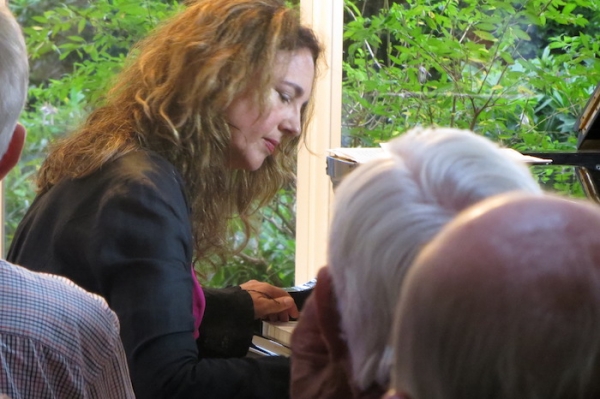
Starr performing at a house concert at Kathy's in Florence, OR 8/16.
SP: Yes, I started at the very beginning and played until the very last night. We did over 1400 shows together, including celebrating and recording our 1000th show at the Hollywood Bowl with Madonna, Duran Duran, Anthony Kiedis from the Chili Peppers and the Tower of Power Horns.
KP: Were you the only woman in the band?
SP: Not originally. Terri Lynne Carrington was the original drummer in the band. She left midway through the first year to tour with her album, and then it was just me.
KP: How did being on that show lead to your playing for Bill Clinton’s Presidential inauguration? I assume that was in 1993?
SP: That’s quite a story. Then governor Bill Clinton, during his run for President, was a guest on the Arsenio Hall Show. He was also a featured musician in the band, playing sax. We played “Heartbreak Hotel” & “God Bless the Child” with him. After rehearsal, we were both in the make-up room getting our faces done and I had a chance to have a really good chat with him about his musical influences.
A little later, but before the show started, I was waiting in the wings to go onto the stage. I always waited for the bass player, John B. Williams, because before going on, we had a good luck handshake that we did every night and by this point, it was a long, complicated, and fun choreography. While I was waiting for John B, Bill Clinton arrived and was waiting to go on stage, too. I told him I really liked his ideas and hoped he would win the election. I asked him, if he won, could our band play at his inauguration. Without hesitation he said “yes.” To ask this sort of thing was TOTALLY and COMPLETELY out of my character to do - it just blurted out of my mouth. After he won the election, he contacted the show and asked for us to play at the Western States Ball at the Kennedy Center for his inauguration - which we did. An unforgettable event to be sure.
KP: Wow! Such a cool story!
You've also played keyboards with a very impressive list of rock, jazz, gospel and soul bands that include members of Earth, Wind and Fire, The Temptations, Maze and Parliament-Funkadelic. You must have been very young and those were some real heavy-hitters. How did that come about?
SP: I was very young and didn’t know enough to be intimidated or afraid! I learned so much from those guys and am so grateful for their mentorship & friendship.
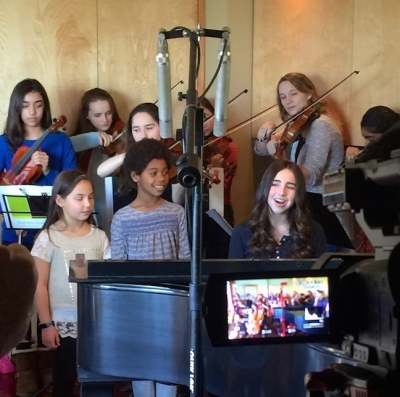
Isolde Fair and classmates performing "To All the Little Girls."
KP: More recently, you and Jeff produced a video for a song your daughter, Isolde, wrote, “To All the Little Girls.” It’s an amazing song! Didn’t you and Isolde perform it for Hillary Clinton a couple of years ago?
SP: Yes!!! Isolde was given an assignment from her music theory teacher to write a song based on the words from Hillary Clinton’s concession speech when she spoke “To all the little girls” about never doubting that they are valuable and powerful and deserving of every opportunity….
Isolde wrote a beautiful song for which her teacher asked Jeff & me to create a string arrangement so that other kids in her string class could participate and play on the song for a recital at her school. We ended up recording the kids playing strings with Isolde singing in our studio. The music teacher had a filmmaker friend, Terry Sanders, whom we also knew, who came over and shot the rehearsal which then became the footage for the video for “To All The Little Girls.”
A couple of weeks after the video was posted, Hillary saw it and tweeted a “thank you” to Isolde and all the girls in the video saying “I’m with you” and sent the link to 13 million of her followers. This lead to a lot of news coverage and interest in the song by people all over the world and The New York Times invited Isolde to come perform it at Lincoln Center for “The Women In World Summit” when she was 13 years old. Hillary was a speaker there and we had a chance to meet her and actually go to another event with her the next day in Houston, Texas where the song was also featured.
KP: That’s pretty heady stuff for a 13-year-old! Isolde is also quite an accomplished violinist - even three years ago when she here with you. Is she planning to become a professional musician, too?
SP: That’s what seems to be in her heart to do.
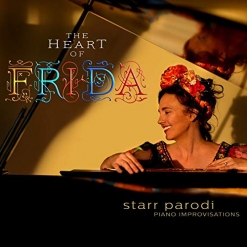
Click on album covers to go to
Kathy's reviews.
KP: Your two award-winning piano albums,
Common Places (2006) and
The Heart of Frida (2016) are both stunning - especially
The Heart of Frida, which was inspired by the life and art of Mexican artist Frida Kahlo. That album includes nine original tracks and two covers of classic rock tunes, one of which is “When Doves Cry.” (The other is one of the very best arrangements I’ve heard of The Moody Blues’ “Nights in White Satin.”) What about Frida inspired you to create a whole album of music based on her life and art? [
Here is the link to Spotify. ]
SP: Thanks so much for your kind words! I’m hoping not to wait so long before the next piano album comes out :-).
Frida Kahlo was the subject of Jeff’s & my first writing assignment for the Laguna Pageant of the Masters, and the theme that first year was “The Muse.” What immediately struck me about Frida, when compared to the other muses featured in the show, was her incredibly strong artistic voice that was not suppressed by the fame of her husband, Diego Rivera, or the tendency of the public to disregard so many women’s work in that era. Her will was strong and incredible in spite of the physical challenges she had to bear throughout her lifetime and I felt she was a huge inspiration to me. I also have strong ties to Mexico through the experiences of my father, Roy Parodi, who lived there as an expat for many years and was a contemporary of Frida’s.
KP: Another amazing story!
Let’s talk about your background. Where were you born and where did you grow up?
SP: I was born in Los Angeles and that’s where I grew up, too. I did attend school in Michigan during my senior year of high school at Interlochen Arts Academy, but then moved back to LA and have lived here ever since.
KP: I read that your father was one of the pioneers in the field of geo-thermal energy. What did he do?
SP: My dad, Roy Parodi, had many different jobs and experiences during his lifetime and was an amazing guy who lived during an amazing time in history. I was born when he was in his sixties and after he passed at the age of 94, I found out many things about his life that I had never known.
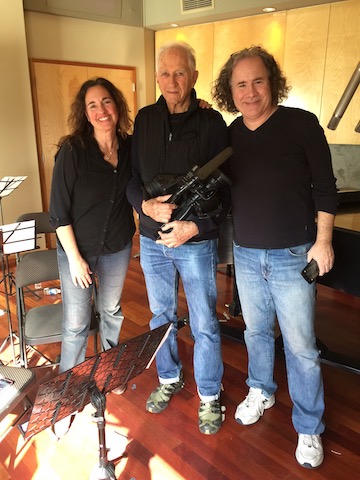
Starr, Terry Sanders and Jeff Fair.
He was the son of Italian immigrants who landed in San Francisco shortly after the turn of the 20th century. He was a young stockbroker during the crash in 1929. Sometime after that, he owned a very well-known destination ranch in San Quentin, Mexico named Hamilton Ranch. He concurrently spent much time in Mexico City and was a contemporary of Diego Rivera and Frida Kahlo. It is legend that the drink the Margarita was named after his first wife, Margarita Henkel, when they visited Hussong’s Cantina on Oct. 7, 1941 and a bartender who was their friend, Don Orozco, first named his new creation after her. I don’t know if the story can ever be verified, but it is something he always told me when I was young.
During WWII he moved back to the U.S. and was a glider pilot in the US Army Air Corp. Fortunately, he never had to fly any missions overseas. After the war, he moved back and forth between Mexico and the States, where he became involved in alternative forms of energy way back in the early days and became an expert in finding & developing geothermal sites all over the world. He met my mom during this time (she was his doctor and had a wholistic practice in Hollywood - she was also a pioneer in her field of medicine & healing).
Dad was quite a guy who lived life to its fullest and I am still discovering things that I never knew about him by going through the many boxes of files and letters that he left behind.
KP: Are any of your family members (other than Jeff and Isolde) musicians?
SP: My grandfather, Amabile Parodi, was a professional accordionist (as well as a cigar maker) in Italy and I found some old manuscripts with polkas that he had written. My mom (Marcella Starr) was a musician in high school playing the trumpet and the timpani. My mom had perfect pitch, but we never knew it until she was at one of my sessions and started calling out the names of the notes that the musicians were playing and blew us all away!
KP: When did you start piano lessons and how long did you take lessons?
SP: I started piano lessons at around 8 years of age, but had a very bad teacher who yelled at me a threw a book at me so I quit and swore I would never play again. When I was around 14 1/2, I went to a friend’s house and sat down at his piano. He showed me some chords and told me I picked it up very quickly and that I should think about playing piano. I went home and started practicing, found a teacher and started studying very seriously soon after that. I had some amazing teachers that changed my life. Piano - (Howard Richman, Harry Fields, Dick Grove), conducting - (Lucas Richman, Jerry Goldsmith). I studied formally until I was about 18 or 19 and then I started learning from records and playing gigs as well as studying scores on my own.
KP: Do you play other instruments (besides keyboards)?
SP: I also play several percussion instruments. I theoretically know how to play the violin because of going to 10 years of violin lessons with my daughter, but I can’t really get a good sound out of it :-)
KP: When did you know that you wanted to be a professional musician?
SP: Very soon after that day I started playing piano again, I started dreaming that music could be my life. The only other profession I ever wanted to do was be an astronaut.
KP: It sounds like you were determined to be a trail-blazer no matter what! How old were you when you wrote your first piece of music?
SP: I was always writing songs and humming melodies into a tape recorder going back to as young as I can remember. Once I started playing piano again, I started writing pieces for the piano too, around the age of 15.
KP: Who do you consider to be some of your musical influences?
SP: All my teachers have been huge musical influences on how I think about harmony and how I approach music. There are so many artists that I have listened to that have shaped my life… and so varied stylistically… Gil Evans, Wayne Shorter, Mavis Staples, Al Green, Herbie Hancock, Patti LaBelle, Joe Zawinul, Sly and the Family Stone, Lisa Batiashvili, Bill Evans, Keith Jarrett, Curtis Mayfield, Radio Head, Pat Metheny, Joni Mitchell, Stevie Wonder…
KP: That IS a varied group! Who are your favorite composers?
SP: For classical composers on the piano I’d have to say Chopin and Debussy. My favorite composer for film is probably Ennio Morricone; The Mission and Cinema Paradiso are my favorite scores of his. Sibelius, Henryk Gorecki & Tchaikovsky are my favorite orchestral/symphonic composers. For contemporary composers, I love to listen to Max Richter & Olafur Arnalds.
KP: What has been your most exciting musical moment to date?
SP: I have found that when I play solo piano, I get to a space in my head and heart where I can totally let go, pray, meditate, release. I discovered this kind of late in life after playing in many bands and doing all sorts of other kinds of playing. When I can totally let go and feel free, and also feel the energy of the audience, this is very exciting to me. I hope my most exciting moments are ahead…
When my daughter and I were onstage together at Lincoln Center, she was singing and playing the piano and I was conducting an orchestra & choir of young girls. She looked over at me while she was singing and gave me a big smile and we connected in such a special mother/daughter moment. I will never forget that feeling of being so connected both musically and personally.
KP: If you could have any three wishes, what would they be?
SP: Pianos you can tune with your mind, my own personal orchestra & eternal Joy and Love, not necessarily in that order.
KP: I love it! Is there anything else you’d like to talk about?
SP: I’m grateful for every moment that I get to play and write and express myself through music.
Many thanks to Starr Parodi for taking the time to chat! For more information about Starr and her music, be sure to visit
her website as well as her
Artist Page here on MainlyPiano.com.
Kathy Parsons
September 2019






